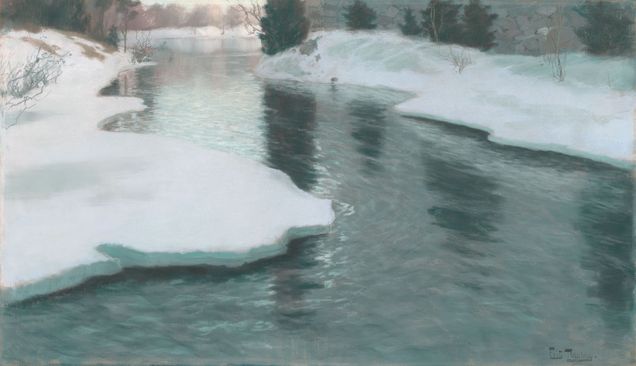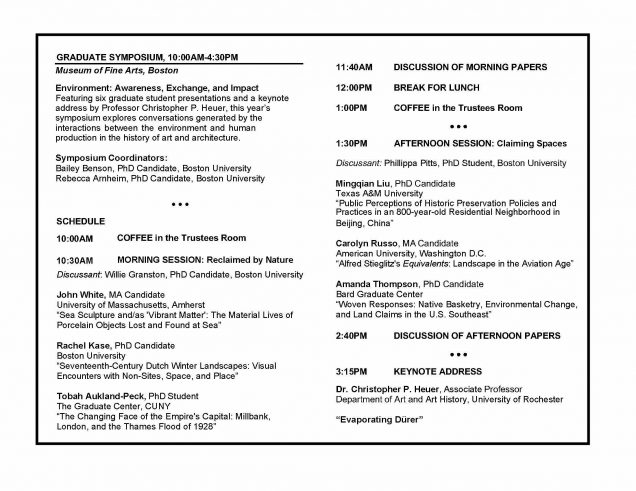Editors’ Introduction
by Rebecca Arnheim and Bailey Benson

When the theme of “Environment” was selected for the 36th Annual Boston University Graduate Symposium in the History of Art & Architecture, we could not imagine how profoundly relevant it would be for the year 2020. The year began with bushfires in Australia that burned more than 46 million acres of land. Intense monsoons severely impacted several countries in Asia and abnormally heavy rainfall in Sudan and Ethiopia resulted in devastating flooding. In the United States, wildfires rage more frequently and with greater intensity in the West of the country, tornado season in the Midwest is getting progressively longer, and tropical storms and hurricanes regularly ravage the southern and eastern coastlines. These are only a few examples of the increasingly common natural disasters that have occurred this year. Then, a novel coronavirus hit the world stage.
Global concerns surrounding COVID-19 reached a fever pitch in early March, just weeks before the symposium was scheduled to take place. The venue was set, speakers had booked their travel, and all things appeared to be proceeding as planned. Almost overnight the whole situation changed. It became increasingly apparent that this event, as with so many others, would not be able to take place as scheduled. After serious deliberation with both the faculty members of the History of Art & Architecture Department at Boston University and representatives from the Museum of Fine Arts, Boston, the difficult decision was made to cancel the symposium. This special edition of SEQUITUR features papers from that canceled symposium.

This year’s graduate symposium was planned for March 28, 2020, at the Museum of Fine Arts, Boston. This event was intended to explore the relationship between the environment and artistic and architectural production (fig. 1). Six graduate students from across the country were invited to share their research, and a keynote address was to be presented by Professor Christopher P. Heuer (University of Rochester). The graduate student presenters were: Tobah Aukland-Peck (The Graduate Center, CUNY), Rachel Kase (Boston University), Mingqian Liu (Texas A&M University), Carolyn Russo (American University), Amanda Thompson (Bard Graduate Center), and John White (University of Massachusetts Amherst). The speakers were to be divided into two panels of three presentations each. The morning session, “Reclaimed by Nature,” was to feature papers focused on nature overcoming human creation and artists’ corresponding reactions. While the morning session focused on nature’s triumph, the afternoon was expected to explore human accomplishments against nature’s forces in a session entitled “Claiming Spaces.”

The present issue of SEQUITUR features papers from four of the presenters. The organization of this issue is intended to reflect that of the event itself (fig. 2). The two parts mirror the two panels, and the papers are presented in the order they would have been delivered at the symposium. Two video Q&A sessions were also recorded in which the authors and the original session moderators, Willie Granston and Phillippa Pitts respectively, further discuss the papers.
The issue begins with Rachel Kase’s paper, which investigates the Little Ice Age’s artistic representations in Dutch art. Kase demonstrates how the monochromatic representations of winter-obscured landscapes disoriented viewers and created instances of “non-sites” in Netherlandish artistic productions. Tobah Aukland-Peck uses miniature displays of World War I battles on display in the Imperial War Museum in order to explore how British citizens dealt with and understood war events that occurred on foreign soil. The choice of materials used to create these models ultimately came to play a central part in how the war was presented to the British citizenry.
Mingqian Liu looks at the built environment, discussing the impacts of preservation efforts on the residents of an 800-year-old historic neighborhood in Beijing, China. Her paper uses interviews with those residents to argue for a bottom-up approach to preservation practices, one that considers the residents and their daily interactions with their built urban environment. The concluding paper of the issue is by Amanda Thompson and deals with the relationships between objects, their makers, and the collections they become a part of—in this case, the British Museum. Thompson uses the example of an eighteenth-century Cherokee basket to demonstrate Native relationships to the environment through the act of weaving and how baskets come to function as objects of land claims as they move into settler spaces.
We hope that this special issue of SEQUITUR invites readers to rethink their own relationships with their environments, both natural and human-made. How does our environment shape us, and how do we shape our environment? The papers featured in this issue serve as good starting points for conversations that can continue outside of the print medium, generating new dialogues and avenues of investigation.